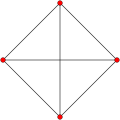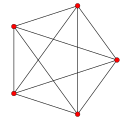Bob
Have a question related to this hub?
Alice
Got something to say related to this hub?
Share it here.
In geometry, a pentagonal polytope is a regular polytope in n dimensions constructed from the Hn Coxeter group. The family was named by H. S. M. Coxeter, because the two-dimensional pentagonal polytope is a pentagon. It can be named by its Schläfli symbol as {5, 3n − 2} (dodecahedral) or {3n − 2, 5} (icosahedral).
The family starts as 1-polytopes and ends with n = 5 as infinite tessellations of 4-dimensional hyperbolic space.
There are two types of pentagonal polytopes; they may be termed the dodecahedral and icosahedral types, by their three-dimensional members. The two types are duals of each other.
The complete family of dodecahedral pentagonal polytopes are:
The facets of each dodecahedral pentagonal polytope are the dodecahedral pentagonal polytopes of one less dimension. Their vertex figures are the simplices of one less dimension.
| n | Coxeter group | Petrie polygon projection |
Name Coxeter diagram Schläfli symbol |
Facets | Elements | ||||
|---|---|---|---|---|---|---|---|---|---|
| Vertices | Edges | Faces | Cells | 4-faces | |||||
| 1 | [ ] (order 2) |
Line segment { } |
2 vertices | 2 | |||||
| 2 | [5] (order 10) |

|
Pentagon {5} |
5 edges | 5 | 5 | |||
| 3 | [5,3] (order 120) |

|
Dodecahedron {5, 3} |
12 pentagons
|
20 | 30 | 12 | ||
| 4 | [5,3,3] (order 14400) |

|
120-cell {5, 3, 3} |
120 dodecahedra
|
600 | 1200 | 720 | 120 | |
| 5 | [5,3,3,3] (order ∞) |
120-cell honeycomb {5, 3, 3, 3} |
∞ 120-cells
|
∞ | ∞ | ∞ | ∞ | ∞ | |
The complete family of icosahedral pentagonal polytopes are:
The facets of each icosahedral pentagonal polytope are the simplices of one less dimension. Their vertex figures are icosahedral pentagonal polytopes of one less dimension.
| n | Coxeter group | Petrie polygon projection |
Name Coxeter diagram Schläfli symbol |
Facets | Elements | ||||
|---|---|---|---|---|---|---|---|---|---|
| Vertices | Edges | Faces | Cells | 4-faces | |||||
| 1 | [ ] (order 2) |
Line segment { } |
2 vertices | 2 | |||||
| 2 | [5] (order 10) |

|
Pentagon {5} |
5 Edges | 5 | 5 | |||
| 3 | [5,3] (order 120) |

|
Icosahedron {3, 5} |
20 equilateral triangles
|
12 | 30 | 20 | ||
| 4 | [5,3,3] (order 14400) |

|
600-cell {3, 3, 5} |
600 tetrahedra
|
120 | 720 | 1200 | 600 | |
| 5 | [5,3,3,3] (order ∞) |
Order-5 5-cell honeycomb {3, 3, 3, 5} |
∞ 5-cells
|
∞ | ∞ | ∞ | ∞ | ∞ | |
The pentagonal polytopes can be stellated to form new star regular polytopes:
In some cases, the star pentagonal polytopes are themselves counted among the pentagonal polytopes.[1]
Like other polytopes, regular stars can be combined with their duals to form compounds;
Star polytopes can also be combined.